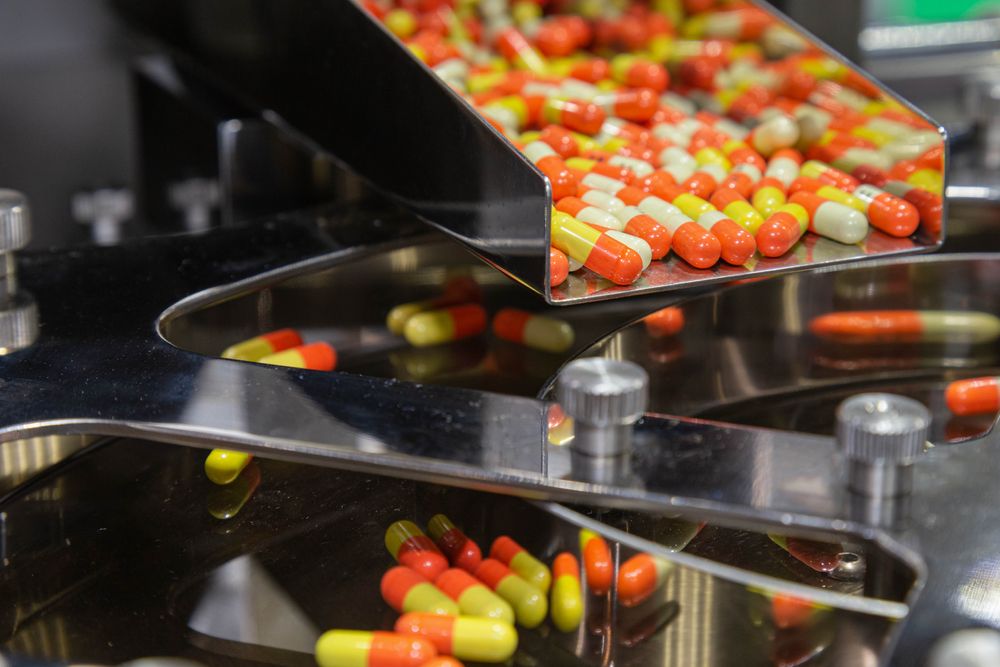Even as Covid-19 spreads like wildfire around the globe irrespective of political boundaries, economic status or military might, there is an even more serious crisis looming in its wake – imminent drug shortages, say Christopher H Lim and Tamara Nair of Nanyang Technological University in Singapore. This could potentially result in the premature deaths of tens of millions of people across the world.
Manufacturing meds, Bangkok: The preoccupation with fighting the Covid-19 pandemic and the urgent search for a vaccine could blind political leaders and public-health authorities to the danger of a global shortage of drugs for chronic and acute ailments such as cardiovascular disease (Credit: Gumpanat / Shutterstock.com)
The experiences of China, South Korea, Italy, Iran, Spain, the US and other countries have shown that, once the coronavirus penetrates a country’s borders, there is no telling how badly it will spread through communities, infecting and killing citizens. Although we are unable to estimate how many deaths Covid-19 will eventually cause, the global preoccupation with fighting the pandemic and the urgent search for a vaccine could blind political and even public-health authorities to a challenge that could turn out to be even more serious: a global shortage of the drugs vitally needed by patients with both acute and chronic ailments such as cardiovascular diseases and certain cancers. This could potentially lead to millions of premature deaths.
According to reports by Deloitte and The Economist Intelligence Unit, non-communicable diseases (NCDs) accounted for 56.9 million deaths globally in 2016. Surveys done in 2013 under the Global Health Security Agenda initiative involving over 30 nations and international organizations including the World Health Organization (WHO) indicated that 70 percent of the countries studied did not have the capacity to comply with the WHO 2005 International Health Regulations that provide guidelines for a public-health response to the spread of a disease.
Dangers beyond Covid-19
On March 11, the WHO declared the coronavirus outbreak a pandemic, prompting many countries around the world to adopt variations of a lockdown – affirmation that the coronavirus had become a global threat. Data have already shown that the elderly and those with pre-existing illnesses are the most susceptible to severe forms of the disease.
The sudden surge in demand for urgent care created by Covid-19 is clearly diverting the attention of healthcare workers away from chronic and acute NCD patients, their treatment postponed (procedures that might normally be regarded as urgent may be delayed) or covered by fewer staff with fewer resources such as beds, protective equipment and even basic medical supplies.
In 2016, there were 17.9 million cardiovascular disease-related deaths around the world, of which heart attacks and strokes accounted for 85 percent and more than 75 percent, respectively, in low- and middle-income countries. In 2018, the WHO reported 18.1 million new cancer cases and 9.6 million cancer-related deaths globally.
Pharmaceutical formulation is the production process which combines APIs and excipients to produce a final medicinal product prior to packaging. Broadly speaking, the manufacturing process is like that used to make specialty chemicals. For example, the production of certain categories of APIs may require 10 or more kinds of pharmaceutical intermediates in a process to transform raw materials into an active ingredient. Pharmaceutical formulation is highly complex, capital intensive and subject to stringent national and international health regulations.
Unlike commodities, APIs must be sourced by certified producers from certified suppliers around the world. Therefore, any disruption to the production or delayed shipments from suppliers will affect global drug production. Lockdowns in many parts of the world can disrupt the production of critical drugs. Care must be exercised to exclude critical pharma ingredients from any form of lockdown or delays that might prevent them from being shipped to production sites.
The discovery and development of new drugs requires pharmaceutical firms to make big risky investments. Based on a survey of 10 pharma companies covering 106 randomly selected new drugs, the estimated average pre-tax industry cost for development of a prescription drug from discovery to US Food and Drug Administration (FDA) approval is US$2.6 billion. In 2018, the return on investment for pharma companies was less than two percent. Both the high costs and limited returns can lead to a decline in research and development (R&D) productivity.
At the same time, many pharma companies are facing a “patent cliff”, a drop in the sales of a drug when its patent expires. The industry’s first such fall took place between 2011 and 2016, with a corresponding revenue loss of US$106 billion. A second patent cliff has been playing out since last year and is expected to run through 2024, resulting in an estimated industry loss of US$114 billion in revenue.
Due to the twin pressures of low R&D productivity and the patent cliff, many pharma giants such as AstraZeneca, GlaxoSmithKline and Pfizer have in the past decade formed strategic partnerships around the world where both ownership and management of the capital-intensive production processes are in the hands of contract manufacturing organizations. This strategic shift has not only helped big pharma giants to lower the high capital cost of production but also reduce the burden of quality and regulatory compliance. These developments have led to highly distributed global supply chains.
The global supply chain structure in pharmaceutical production spans multiple drug application areas including treatments for conditions in cardiology, oncology, pulmonology, neurology, diabetes control, and pain management. Domestic US firms are the top suppliers (28 percent) of APIs for the US pharma market, followed by suppliers in European Union nations (26 percent), India (18 percent), and China (13 percent). Protracted disruptions as a result of the Covid-19 pandemic such as the shutting down of Chinese factories could lead to a global shortage of ingredients for the production of other drugs, particularly in North America and EU, which together account for 56 percent of global production.
Preventing another global health crisis
Healthcare facilities in most countries are now dedicated to fighting Covid-19. Understandably, it would be a very daunting task for many national health authorities to consider planning and building strategic stockpiles of drugs used for other serious diseases. There are compelling reasons to do so.
Without the timely supply of critical drugs, many medical procedures for non-Covid-19 illnesses will be compromised and potentially resulting in the premature deaths of at least tens of million people globally. Not having access to important medication for patients with pre-existing conditions can make them more vulnerable if they should test positive for Covid-19. This can compromise already stretched resources and healthcare personnel. A singular case in point was the rush to use hydroxychloroquine as a Covid-19 treatment, despite weak anecdotal evidence of its effectiveness. This led to a shortage of the drug on which lupus and rheumatoid arthritis patients relied.
In anticipation of these of drug shortages, a well-planned, multi-pronged approach might be called for rather than channelling all resources to one disease, even if eradicating Covid-19 is a clear priority. There are more than 200 countries and territories infected by Covid-19 and there is great uncertainty as to how long this pandemic will last. Without a smart strategy for drug manufacturing and distribution across products, the coronavirus could well lead to another global health crisis, with significant collateral damage – a sharp rise in deaths from chronic and acute diseases.
Further reading:
Christopher H Lim
S Rajaratnam School of International Studies (RSIS), Nanyang Technological University (NTU)
Tamara Nair
S Rajaratnam School of International Studies (RSIS), Nanyang Technological University (NTU)
Check out here for more research and analysis from Asian perspectives.



